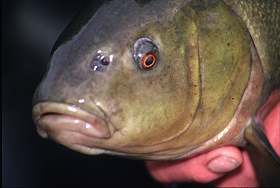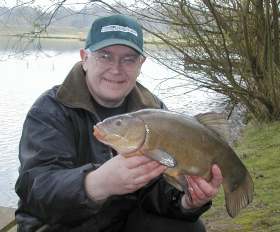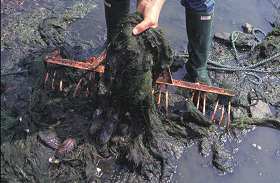I lost my first tench from the Macclesfield canal where it runsthrough Congleton in Cheshire. It was to be a stinking hot day, andeven at 6.00am I fished in a short-sleeved shirt. I was fishing aswim known as Astbury Wide, a spot where the canal broadened to allowthe barges to turn round, and just a 15 minute bike ride from myhome. I was fishing for roach with the usual crow-quill float and11/2 lb line to a 14’s eyed hook. Bread flake was bait for severalreasons; maggots were not readily available, and we didn’t have afridge in 1951 to keep them fresh; it was so much easier to cut achunk off a loaf for that early morning session before school, andthe roach loved it. It was also the perfect bait to go with thehome-made groundbait I used to crush from stale bread with a milkbottle.
|
|
| |
A yard or two from the margins
I remember the morning as though it was yesterday. I had cast myusual yard to two yards from the marginal rushes and struck at thefirst bite within seconds. I had forgotten to put the ratchet on thecentre-pin reel and caused a massive bird’s nest. It was a bad one,for the end result was that this bird’s nest jammed in and around oneof the runners on the 10ft split cane rod. I was left with twochoices, either to fish within a few inches of the rushes, simplydropping the float more or less below the rod end, or to go back homeand prepare for yet another boring day at school. Anything was betterthan the latter. Where a bad day’s fishing is better than a good dayat work, a bad hour’s fishing is infinitesimally better than even theprospect of school when you’re nine years old.
|
|
| |
So the bread flake was lowered in right by the rushes, and I satback on my basket not really expecting to catch anything, for at thatage you need some convincing that the best place to fish is notalways in the middle, or at least as close as you can get to it. Ihadn’t altered the depth I was fishing and my float was lyinghalf-cock due to the bottom shot now lying well on the bottom ratherthan being held up by the float. I had thrown all my groundbait intothe far swim before the bird had nested in my rod runner and Ithought my prospects of catching anything were about as good assomeone running a mile in less than four minutes. Which of course SirRoger Bannister did in 3 minutes 59.4 seconds on 6 May three yearslater, breaking the then world record.
Just as I was wondering whether to collect a pocketful of stonesfor catty ammo my float suddenly stood up and waved at me. I had myhand on the rod when the float disappeared, and then found I wasconnected to a mad creature that pulled at the rod like nothing hadever pulled on it before. How I even got it to the top was due moreto luck than anything else, but I did, and for long enough to see thesmooth, olive skin, the red eye and big paddle of a tail as itdisappeared forever, taking my hook and a few inches of line with it.I had seen only pictures of tench before, now I had seen one forreal. I cursed that bird’s nest, but went home with my head swimmingwith plans to catch a tench. Now I knew when, where and how to catcha tench, which I did in that same spot a few day’s later.
Small beginnings, but a lesson learned that was never forgotten.Tench were best caught when the weather is warm, in the earlymorning, fishing tight up to marginal vegetation, with a bait thatlay hard on the bottom. That holds good today, many years later, butobviously with the usual exceptions to the rules that make fishingwhat it is, a subjective rather than an objective sport. Perhaps thegreatest value of the lesson I learned that day is that it may havebeen my first inkling that the best way to catch fish is to learnabout their habits, particularly their feeding habits, and then tocapitalise on that knowledge.
|
|
| |
The Doctor Fish
At one time known as the Doctor Fish, due to a mythical belief thattheir body mucous had healing properties, I have to rate the tenchamong my best-loved species. They are found in all types ofstillwater, from tiny ponds to massive reservoirs and gravel pits,and in some slow-flowing rivers. Though I have to say they seem mostat home in shallow, lily-dotted estate lakes. Not too difficult tocatch, yet not too easy. Beautiful to look at, yet as tough as oldboots. It has a sleek, shiny, almost varnished, body, not unlike apolished carving from dark oak, although the colouring can vary fromvery dark brown, through green, to a very light, golden hue. Whenseen in the water it doesn’t move, but glides, slipping through weedwith the same ease as wire slicing through cheese and with the graceof a ballet dancer. That veneered body, however, hides coiled musclesthat impart such power into massive fins you have a bare knucklefight on your hands that gives no quarter. The male tench, one of thefew fish whose gender can be identified easily by the layman, haseven bigger fins, and a fighting tenacity that belies its size. Likeall freshwater species the Male tench is generally smaller than thefemale, and it is popularly thought that the ultimate size of themale tench is about half the ultimate size of the female in a givenwater. I think the truth is something less than that, ie, a waterwhere the biggest males are around 6lb has the potential to producefemales of 10lb to 11lb.
Tench love warm water
Tench are lovers of warm water, in spite of the fact that a few tenchare caught each winter. The upper 60’s Fahrenheit, to around themid-70’s are best, but lower temperatures cannot be ruled out at theright time of year. As I have said so often before, it isn’t thenumbers that matter where water temperature is concerned, but thetrend of those numbers. A rising water temperature in, say, the upper50’s, in spring, will encourage tench to feed far more than a fallingtemperature in the upper 60’s in mid-summer.
At this time of year the water can be very clear and therefore thelight can penetrate deeply, so this usually means the early morningfeeding period will be short on those days when there is no cloudcover.
Unpredictable at times
Tench are a contradictory creature, though, for I have made some ofmy best catches of big tench on a few waters around mid-day, when thesun was at its highest and therefore the light able to penetrate toits maximum. In spite of racking the old brain cells over the years,in the effort to try and find a pattern, I have never been able to.It would make more sense if, on those days when they feed on a brightmid-day, the water was cold and a rise in temperature was the crucialfactor. Yet that is not the case, for it happens during a run of warmdays, when the water temperature is perfect for tench. It happensduring a cold spell. It happens when it is calm and when it is windy,and in whatever direction the wind is blowing. And it happens whenthe water is crystal-clear or coloured. I have even noted the moonphases when it happens and found no connection.
|
|
| |
Dawn is usually best
There are more waters, however, where the tench rarely, if ever, feedbeyond that important dawn plus three hour period. Where theyoccasionally feed in the late evening and through the night. Thegeneral pattern also includes the fact that tench will extend theirfeeding period on overcast days, when the sun is not allowed to makean appearance. So when you are faced with a water you have neverfished before, go for the early morning period, and then experimentfrom there.
Not often nocturnal
Accepting then, that for the most part, tench are inclined to feedbest in the early morning, from dawn until the sun rises high enoughto have an effect beneath the surface of the water, and on overcastdays, why are so few tench caught through the night? The light (orlack of it) is right, the water is at its warmest, at least for thefirst few hours of darkness, and all other bottom feeding species areinclined to be nocturnal. Yes, I know that tench are caught whennight fishing – I’ve caught enough of them myself at that time. Yetcompared to the number of tench caught in the early morning and lateevening the night-caught ones are well in the minority. If, as we allaccept, tench are generally not lovers of bright light, why are theytherefore not inclined to feed more through the night, just as manyother bottom feeding species do? I have heard many theories aboutthis, but none that cannot be shot full of holes. It has been saidthat weedy waters, which are typical tench venues, give off too muchcarbon dioxide from the weed at night and therefore there is notenough oxygen to encourage the tench to feed. But that won’t wash,for the other species present in most of them, such as bream andcarp, feed through the night, and tench require less oxygen to thrivethan either of those species. Theoretically, specially where thelight factor is concerned, tench should feed more at night than anyother time. But they don’t. Of course, there are waters where tenchare caught mainly at night, and waters where they are caughtoccasionally at night. But there are many more waters where only atiny percentage of tench are caught during the dark hours, comparedto what those same waters produce during the day.
Tench love weed
Tench and weed go together like hair-rigs and boilies. Find one andthe other won’t be far away. Any kind of weed is attractive to them,but broad-leaved emergent plants are mainly used for shade and bottomweeds for food supply. Where there are fairly tall marginal reeds, orwhere broad leaves on the surface grow from the top of a shelf -which is often the case – and cast their shade over a shelf whereweedy larders grow from the bottom, you have an ideal environment fortench.
The natural food of mature tench are bloodworms and waterlice insilty-bottomed waters, with molluscs, such as snails, mussels andshrimps, making up their staple diet on hard, gravelly andsandy-bottomed waters. Like all fish they will eat smaller fish whenthe inclination and opportunity arises, and have been known to takehatching insects from the surface. I have seen evidence of themeating soft weed (filamentous algae) but I’m not sure if this wasdeliberate or the result of taking it along with the shrimps, snailsand pea mussels that live in it.
Tench feed in groups
Tench are not loners. They roam and feed in groups of half a dozen orso, although they are not shoal fish in the strictest sense of theword. True shoal fish are like a regiment of soldiers who feed andmove as one, whereas tench move and feed in small groups, but eachappearing to maintain its individuality. When very large catches oftench are made it is usually because a number of groups have cometogether at the same time to feed in the baited area.
|
|
| |
Raking a swim
Tench are an apparently fearless fish in some instances and aregreatly attracted to an area where the bottom has been disturbed andcaused the water to become cloudy. No doubt they associate cloudypatches with feeding activity and home in to ensure they have some ofthe action. Raking a swim, an old trick used by tench fishers for aslong as we have records, serves the purpose of releasing food fromthe bottom and causing a cloudy area. Most of the large catches oftench I’ve had have come from raked swims in weedy spots, whennumerous groups of tench have homed in to that same area.
Many anglers are reluctant to rake a swim, specially when thetarget is large tench, for they fear that the disturbance will ruintheir chances. I have never found this to be the case. In fact, oncountless occasions I have had the first bite within minutes of therake being pulled from the water for the last time. Even so, I havenever yet had the courage to rake a swim again, part way through asession, when the bites have tapered off, to see if that would revivetheir interest. This year I aim to remedy that, so we will see whathappens.
Although I am never reluctant to rake a swim, I am not under theillusion that tench will tolerate any and all kinds of disturbance.They may be tolerant of rakes causing havoc for a few minutes, andonly retreat while the commotion is taking place, but I’m sure thereason for this tolerance is solely because they associate theactivity with food rather than danger. A careless movement againstthe skyline, however, or a heavy footfall on the bank, soon causesthem to take flight. I have sat close to the edge of a waterfloat-fishing under my rod end, and seen tench scorch away in panicsimply from the movement of the rod above their heads. Whenever Ican, I sit well back from the water’s edge and keep the rod out ofsight. When I cast I overcast by several yards and then draw gentlyback to allow the bait to fall quietly through the water.
Never give up
It has to be said, however, that where tench are concerned you cannottake anything for granted. The only real pattern to their behaviourin many instances is that there is no pattern. In this respect theyare totally unpredictable. It is this factor, as much as anything,that I love about the species. Even on the most dire day, when allseems lost, and you reckon your chances of catching one are almostzero, you should never give up.















